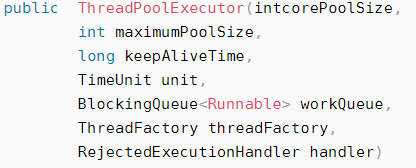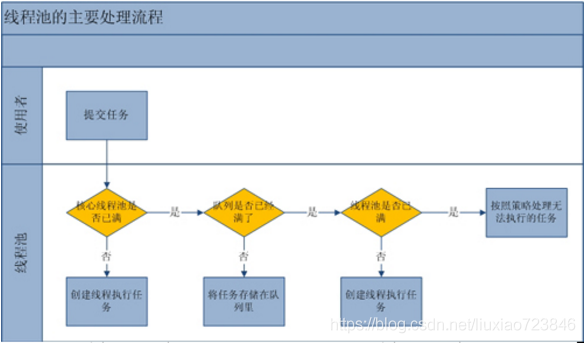全网最详细的线程池 ThreadPoolExecutor 详解,建议收藏! |
您所在的位置:网站首页 › 线程池参数设置原则 › 全网最详细的线程池 ThreadPoolExecutor 详解,建议收藏! |
全网最详细的线程池 ThreadPoolExecutor 详解,建议收藏!
|
一、ThreadPoolExecutor类讲解
1、线程池状态:
五种状态:
注:SHUTDOWN 状态 和 STOP 状态 先会转变为 TIDYING 状态,最终都会变为 TERMINATED 2、ThreadPoolExecutor构造函数:ThreadPoolExecutor继承自AbstractExecutorService,而AbstractExecutorService实现了ExecutorService接口。
接下来我们分别讲解这些参数的含义。 2.1)线程池工作原理: corePoolSize :线程池中核心线程数的最大值 maximumPoolSize :线程池中能拥有最多线程数 workQueue:用于缓存任务的阻塞队列当调用线程池execute() 方法添加一个任务时,线程池会做如下判断: 如果有空闲线程,则直接执行该任务; 如果没有空闲线程,且当前运行的线程数少于corePoolSize,则创建新的线程执行该任务; 如果没有空闲线程,且当前的线程数等于corePoolSize,同时阻塞队列未满,则将任务入队列,而不添加新的线程; 如果没有空闲线程,且阻塞队列已满,同时池中的线程数小于maximumPoolSize ,则创建新的线程执行任务; 如果没有空闲线程,且阻塞队列已满,同时池中的线程数等于maximumPoolSize ,则根据构造函数中的 handler 指定的策略来拒绝新的任务。
当一个线程无事可做,超过一定的时间(keepAliveTime)时,线程池会判断,如果当前运行的线程数大于 corePoolSize,那么这个线程就被停掉。所以线程池的所有任务完成后,它最终会收缩到 corePoolSize 的大小。 注:如果线程池设置了allowCoreThreadTimeout参数为true(默认false),那么当空闲线程超过keepaliveTime后直接停掉。(不会判断线程数是否大于corePoolSize)即:最终线程数会变为0。 2.3)workQueue 任务队列: workQueue :它决定了缓存任务的排队策略 ThreadPoolExecutor线程池推荐了三种等待队列,它们是:SynchronousQueue 、LinkedBlockingQueue 和 ArrayBlockingQueue。 1)有界队列: SynchronousQueue :一个不存储元素的阻塞队列,每个插入操作必须等到另一个线程调用移除操作,否则插入操作一直处于 阻塞状态,吞吐量通常要高于LinkedBlockingQueue,静态工厂方法 Executors.newCachedThreadPool 使用了这个队列。 ArrayBlockingQueue:一个由数组支持的有界阻塞队列。此队列按 FIFO(先进先出)原则对元素进行排序。一旦创建了这样的缓存区,就不能再增加其容量。试图向已满队列中放入元素会导致操作受阻塞;试图从空队列中提取元素将导致类似阻塞。 2)无界队列: LinkedBlockingQueue:基于链表结构的无界阻塞队列,它可以指定容量也可以不指定容量(实际上任何无限容量的队列/栈都是有容量的,这个容量就是Integer.MAX_VALUE) PriorityBlockingQueue:是一个按照优先级进行内部元素排序的无界阻塞队列。队列中的元素必须实现 Comparable 接口,这样才能通过实现compareTo()方法进行排序。优先级最高的元素将始终排在队列的头部;PriorityBlockingQueue 不会保证优先级一样的元素的排序。注意:keepAliveTime和maximumPoolSize及BlockingQueue的类型均有关系。如果BlockingQueue是无界的,那么永远不会触发maximumPoolSize,自然keepAliveTime也就没有了意义。 2.4)threadFactory:threadFactory :指定创建线程的工厂。(可以不指定) 如果不指定线程工厂时,ThreadPoolExecutor 会使用ThreadPoolExecutor.defaultThreadFactory 创建线程。默认工厂创建的线程:同属于相同的线程组,具有同为 Thread.NORM_PRIORITY 的优先级,以及名为 “pool-XXX-thread-” 的线程名(XXX为创建线程时顺序序号),且创建的线程都是非守护进程。 2.5)handler 拒绝策略:handler :表示当 workQueue 已满,且池中的线程数达到 maximumPoolSize 时,线程池拒绝添加新任务时采取的策略。(可以不指定)
最科学的的还是 AbortPolicy 提供的处理方式:抛出异常,由开发人员进行处理。 3、常用方法:除了在创建线程池时指定上述参数的值外,还可在线程池创建以后通过如下方法进行设置。
此外,还有一些方法: getCorePoolSize():返回线程池的核心线程数,这个值是一直不变的,返回在构造函数中设置的coreSize大小; getMaximumPoolSize():返回线程池的最大线程数,这个值是一直不变的,返回在构造函数中设置的coreSize大小; getLargestPoolSize():记录了曾经出现的最大线程个数(水位线); getPoolSize():线程池中当前线程的数量; getActiveCount():Returns the approximate(近似) number of threads that are actively executing tasks; prestartAllCoreThreads():会启动所有核心线程,无论是否有待执行的任务,线程池都会创建新的线程,直到池中线程数量达到 corePoolSize; prestartCoreThread():会启动一个核心线程(同上); allowCoreThreadTimeOut(true):允许核心线程在KeepAliveTime时间后,退出; 4、Executors类:Executors类的底层实现便是ThreadPoolExecutor!Executors 工厂方法有: Executors.newCachedThreadPool():无界线程池,可以进行自动线程回收 Executors.newFixedThreadPool(int):固定大小线程池 Executors.newSingleThreadExecutor():单个后台线程它们均为大多数使用场景预定义了设置。不过在阿里java文档中说明,尽量不要用该类创建线程池。 二、线程池相关接口介绍: 1、ExecutorService接口:该接口是真正的线程池接口。上面的ThreadPoolExecutor以及下面的ScheduledThreadPoolExecutor都是该接口的实现类。改接口常用方法: Future submit(Runnable task):提交Runnable任务到线程池,返回Future对象,由于Runnable没有返回值,也就是说调用Future对象get()方法返回null; Future submit(Callable task):提交Callable任务到线程池,返回Future对象,调用Future对象get()方法可以获取Callable的返回值; Future submit(Runnable task,T result):提交Runnable任务到线程池,返回Future对象,调用Future对象get()方法可以获取Runnable的参数值; invokeAll(collection of tasks)/invokeAll(collection of tasks, long timeout, TimeUnit unit):invokeAll会按照任务集合中的顺序将所有的Future添加到返回的集合中,该方法是一个阻塞的方法。只有当所有的任务都执行完毕时,或者调用线程被中断,又或者超出指定时限时,invokeAll方法才会返回。当invokeAll返回之后每个任务要么返回,要么取消,此时客户端可以调用get/isCancelled来判断具体是什么情况。 invokeAny(collection of tasks)/invokeAny(collection of tasks, long timeout, TimeUnit unit):阻塞的方法,不会返回 Future 对象,而是返回集合中某一个Callable 对象的结果,而且无法保证调用之后返回的结果是哪一个 Callable,如果一个任务运行完毕或者抛出异常,方法会取消其它的 Callable 的执行。和invokeAll区别是只要有一个任务执行完了,就把结果返回,并取消其他未执行完的任务;同样,也带有超时功能; shutdown():在完成已提交的任务后关闭服务,不再接受新任; shutdownNow():停止所有正在执行的任务并关闭服务; isTerminated():测试是否所有任务都执行完毕了; isShutdown():测试是否该ExecutorService已被关闭。 1.1)submit方法示例:我们知道,线程池接口中有以下三个主要方法,接下来我们看一下具体示例:
在上面的例子中我们可以看到,线程池无论是执行Callable还是Runnable,调用返回的Future对象get()方法时需要处理两种异常(如果是调用get(timeout)方法,需要处理三种异常),如下: //在线程池上运行 Future future = threadPool.submit(callable); try { System.out.println("feature.get"); Object x = future.get(900,TimeUnit.MILLISECONDS); System.out.println(x); } catch (InterruptedException e) { e.printStackTrace(); } catch (ExecutionException e) { System.out.println("execute exception..."); e.printStackTrace(); } catch (TimeoutException e) { e.printStackTrace(); } 如果get方法被打断,进入InterruptedException异常; 如果线程执行过程(call、run方法)中抛出异常,进入ExecutionException异常; 如果get方法超时,进入TimeoutException异常; 1.3)submit()和execute()方法区别:ExecutorService、ScheduledExecutorService接口的submit()和execute()方法都是把任务提交到线程池中,但二者的区别是 接收的参数不一样,execute只能接收Runnable类型、submit可以接收Runnable和Callable两种类型; submit有返回值,而execute没有返回值;submit方便Exception处理; 1)submit方法内部实现:其实submit方法也没有什么神秘的,就是将我们的任务封装成了RunnableFuture接口(继承了Runnable、Future接口),再调用execute方法,我们看源码: public Future submit(Runnable task) { if (task == null) throw new NullPointerException(); RunnableFuture ftask = newTaskFor(task, null); //转成 RunnableFuture,传的result是null execute(ftask); return ftask; } public Future submit(Runnable task, T result) { if (task == null) throw new NullPointerException(); RunnableFuture ftask = newTaskFor(task, result); execute(ftask); return ftask; } public Future submit(Callable task) { if (task == null) throw new NullPointerException(); RunnableFuture ftask = newTaskFor(task); execute(ftask); return ftask; } 2)newTaskFor方法内部实现:newTaskFor方法是new了一个FutureTask返回,所以三个方法其实都是把task转成FutureTask,如果task是Callable,就直接赋值,如果是Runnable 就转为Callable再赋值。 当submit参数是Callable 时: protected RunnableFuture newTaskFor(Callable callable) { return new FutureTask(callable); } public FutureTask(Callable callable) { if (callable == null) throw new NullPointerException(); this.callable = callable; this.state = NEW; }当submit参数是Runnable时: // 按顺序看,层层调用 protected RunnableFuture newTaskFor(Runnable runnable, T value) { return new FutureTask(runnable, value); } public FutureTask(Runnable runnable, V result) { this.callable = Executors.callable(runnable, result); //转 runnable 为 callable this.state = NEW; } // 以下为Executors中的方法 public static Callable callable(Runnable task, T result) { if (task == null) throw new NullPointerException(); return new RunnableAdapter(task, result); } static final class RunnableAdapter implements Callable { //适配器 final Runnable task; final T result; RunnableAdapter(Runnable task, T result) { this.task = task; this.result = result; } public T call() { task.run(); return result; } }看了源码就揭开了神秘面纱了,就是因为Future需要返回结果,所以内部task必须是Callable,如果task是Runnable 就偷天换日,在Runnable 外面包个Callable马甲,返回的结果在构造时就写好。 参考:https://blog.csdn.net/liuxiao723846/article/details/108024212 1.4)ScheduledExecutorService接口:继承ExecutorService,并且提供了按时间安排执行任务的功能,它提供的方法主要有: schedule(task, initDelay): 安排所提交的Callable或Runnable任务在initDelay指定的时间后执行; scheduleAtFixedRate():安排所提交的Runnable任务按指定的间隔重复执行; scheduleWithFixedDelay():安排所提交的Runnable任务在每次执行完后,等待delay所指定的时间后重复执行;注:该接口的实现类是ScheduledThreadPoolExecutor。 2、Callable接口:jdk1.5以后创建线程可以通过一下方式: 继承Thread类,实现void run()方法; 实现Runnable接口,实现void run()方法; 实现Callable接口,实现V call() Throws Exception方法 1)Callable和Runnale接口区别: Callable可以抛出异常,和Future、FutureTask配合可以用来获取异步执行的结果; Runnable没有返回结果,异常只能内部消化; 2)执行Callable的线程的方法可以通过以下两种方式: 借助FutureTask,使用Thread的start方法来执行; 加入到线程池中,使用线程池的execute或submit执行;注:Callable无法直接使用Thread来执行; 我们都知道,Callable带有返回值的,如果我们不需要返回值,却又想用Callable该如何做? jdk中有个Void类型(大写V),但必须也要return null。 threadpool.submit(new Callable() { @Override public Void call() { //... return null; } }); 3)通过Executors工具类可以把Runnable接口转换成Callable接口:Executors中的callable方法可以将Runnable转成Callable,如下: public static Callable callable(Runnable task, T result) { if (task == null) throw new NullPointerException(); return new RunnableAdapter(task, result); }RunnableAdapter类在上面已经看过源码,原理就是将返回值result作为成员变量,通过参数传递进去,进而实现了Runnable可以返回值。 示例: public static void test5() { Person p = new Person(0,"person"); RunnableTask runnableTask = new RunnableTask(p);//创建runnable Callable callable = Executors.callable(runnableTask,p);//转换 Future future1 = threadPool.submit(callable);//在线程池上执行Callable try { Person person = future1.get(); System.out.println(person); } catch (InterruptedException | ExecutionException e) { e.printStackTrace(); } Runnable runnable = new Runnable() {//创建Runnable @Override public void run() { } }; Callable callable2 = Executors.callable(runnable);//转换 Future future2 = threadPool.submit(callable2);//在线程池上执行Callable try { Object o = future2.get(); System.out.println(o); } catch (InterruptedException | ExecutionException e) { e.printStackTrace(); } } 3、Future接口: 3.1)Future是用来获取异步计算结果的接口,常用方法: boolean cancel(boolean mayInterruptIfRunning):试图取消对此任务的执行。如果任务已完成、或已取消,或者由于某些其他原因而无法取消,则此尝试将失败。当调用 cancel 时,如果调用成功,而此任务尚未启动,则此任务将永不运行。如果任务已经启动,则 mayInterruptIfRunning 参数确定是否应该以试图停止任务的方式来中断执行此任务的线程。此方法返回后,对 isDone() 的后续调用将始终返回 true。如果此方法返回 true,则对 isCancelled() 的后续调用将始终返回 true。 boolean isCancelled():如果在任务正常完成前将其取消,则返回 true。 boolean isDone():如果任务已完成,则返回 true,可能由于正常终止、异常或取消而完成,在所有这些情况中,此方法都将返回 true。 V get()throws InterruptedException,ExecutionException:获取异步结果,此方法会一直阻塞等到计算完成; V get(long timeout,TimeUnit unit) throws InterruptedException,ExecutionException,TimeoutException:获取异步结果,此方法会在指定时间内一直阻塞等到计算完成,超时后会抛出超时异常。通过方法分析我们也知道实际上Future提供了3种功能: 能够中断执行中的任务; 判断任务是否执行完成; 获取任务执行完成后额结果。但是Future只是一个接口,我们无法直接创建对象,因此就需要其实现类FutureTask登场啦。 3.2)FutureTask类: 1)FutureTask类的实现: public class FutureTask implements RunnableFuture { //... } public interface RunnableFuture extends Runnable, Future { /** * Sets this Future to the result of its computation * unless it has been cancelled. */ void run(); }FutureTask实现了Runnable、Future两个接口。由于FutureTask实现了Runnable,因此它既可以通过Thread包装来直接执行,也可以提交给ExecuteService来执行。并且还可以直接通过get()函数获取执行结果,该函数会阻塞,直到结果返回。 因此FutureTask既是Future、Runnable,又是包装了Callable( 如果是Runnable最终也会被转换为Callable ), 它是这两者的合体。 2)FutureTask的构造函数: public FutureTask(Callable callable) { } public FutureTask(Runnable runnable, V result) { } 3.3)示例:(FutureTask两种构造函数、以及在Thread和线程池上运行) 1)FutureTask包装过的Callable在Thread、线程池上执行: public static void test3() { int a = 1,b = 2; Callable callable = new Callable() { @Override public Integer call() throws Exception { return a + b; } }; //通过futureTask来执行Callable FutureTask futureTask = new FutureTask(callable); //1.使用Thread执行线程 new Thread(futureTask).start(); try { Integer integer = futureTask.get(); System.out.println(integer); } catch (InterruptedException e) { e.printStackTrace(); } catch (ExecutionException e) { e.printStackTrace(); } //2.使用线程池执行线程 Executors.newFixedThreadPool(1).submit(futureTask); threadPool.shutdown(); try { Integer integer = futureTask.get(); System.out.println(integer); } catch (InterruptedException | ExecutionException e) { e.printStackTrace(); } } 2)FutureTask包装过的Runnable在Thread、线程池上执行: public static void test4() { Person p = new Person(0,"person"); RunnableTask runnableTask = new RunnableTask(p); //创建futureTask来执行Runnable FutureTask futureTask = new FutureTask(runnableTask,p); //1.使用Thread执行线程 new Thread(futureTask).start(); try { Person x = futureTask.get(); System.out.println(x); } catch (InterruptedException | ExecutionException e) { e.printStackTrace(); } //2.使用线程池执行线程 threadPool.submit(futureTask); threadPool.shutdown(); try { Person y = futureTask.get(); System.out.println(y); } catch (InterruptedException | ExecutionException e) { e.printStackTrace(); } }Person、RunnableTask类同上面的示例中。 来源:https://blog.csdn.net/liuxiao723846 更多文章推荐: 1.Spring Boot 3.x 教程,太全了! 2.2,000+ 道 Java面试题及答案整理(2024最新版) 3.免费获取 IDEA 激活码的 7 种方式(2024最新版) 觉得不错,别忘了随手点赞+转发哦! |
【本文地址】
今日新闻 |
推荐新闻 |





